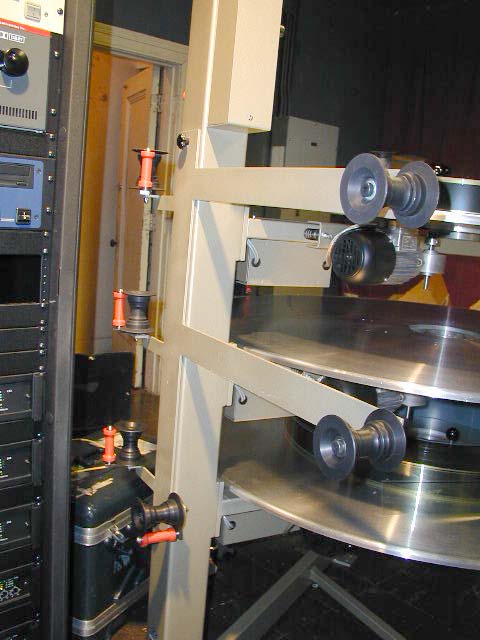|
|
This topic comprises 2 pages: 1 2
|
|
Author
|
Topic: Kinotone ST200 Platter
|
|
|
|
|
Michael Barry
Jedi Master Film Handler

Posts: 584
From: Sydney, NSW, Australia
Registered: Nov 1999
|
 posted 04-26-2002 10:06 AM
posted 04-26-2002 10:06 AM




Steve,The ST-200's that we have at work are exactly the same as the one shown at this link:
http://www.kinoton.com/iprodukte.htm From that link, click 'Cinema Products', then 'Non-Rewind Systems', for a photo of all models. Actually, it looks more like the ST-270, the 35/70MM equivalent. The difference is that those extension arms are present in the 35/70 version to facilitate more gentle twists for 70MM operation. Either way, going by the method that the ones we have at work take up to the bottom plate, you don't thread to the bottom-left return roller the way you do to go to the middle or top plates. Instead, you simply bypass it and go directly to the perpendicular roller (the one directly corresponding to the lower plate) just behind it. From there, you simply go to the control arm roller on the lower plate then wrap the film to the centre ring to take up counter-clockwise as per usual. I hope that description makes sense. When you take up to the lower plate, the film barely twists at all. From the lower gimbled magazine under the projector, all the film has to do is become perpendicular - a 45 degree twist at best, so it's suitable for 70MM operation. Obviously, the height of the projector's lower gimbled magazine roller must be similar with the take-up rollers on the lower plate of the platter for this to function. It's only when the film must travel to the middle or top plates that the extension arms come into play for a 'Z' shaped take up pattern. (Top plate take-up would go: lower roller, across to middle extension, then up to top extension, then twist to top roller next to column, then control arm, then centre ring.) My description applies to the platter being on the operator side of the projector. If the platter is on the other side of the projector, then the film simply wraps around that lower perpendicular roller next to the main column from the other side, goes to the control arm then back around to the centre ring for a 'Z' pattern (viewed from the top). The degree of film twisting is identical. John Wilson comes back next week with his digital camera so we can take pictures of film returning to the lower plates if you like. We have examples of both operator and non-operator paths. 
| IP: Logged
|
|
Larry Shaw
Expert Film Handler

Posts: 238
From: Boston, MA, USA
Registered: Mar 2000
|
 posted 04-26-2002 06:41 PM
posted 04-26-2002 06:41 PM





Steve,If you go to http://www.blsi.com/kinoton/technical.htm and look at Tech Note # 01-5 you will find a link to a image of exactly how to thread that deck on that platter. I'm a lot of things, but, at least in this case, I'm not stumped. -Larry ------------------
Larry Shaw
Boston Light & Sound, Inc.
North American Distributor of Kinoton GmbH
290 North Beacon Street
Boston, MA 02135-1990
Tel: 617-787-3131 x104 Fax: 617-787-4257
E-Mail: larry@blsi.com
Web site: http://www.blsi.com/kinoton
| IP: Logged
|
|
|
|
|
|
|
|
|
|
|
|
|
|
Larry Shaw
Expert Film Handler

Posts: 238
From: Boston, MA, USA
Registered: Mar 2000
|
 posted 04-29-2002 03:44 PM
posted 04-29-2002 03:44 PM





The reasoning behind the roller design is less rollers is better. Every roller adds drag, and a potential for damage from misthreading. Additionally, adjustable input and output rollers can be (and in my experience often are) misadjusted either by poor installers or incompetent/careless operators so as to damage film. I've also seen a number of setups with the film dragging across the floor because of low input roller position and excessive projector-to-platter distance. Further, the thinking is that if additional rollers are sometimes needed to correct height and/or position variences they are best installed in fixed positions by competent installers who can carefully position them to allow sufficent distances for the twists required. Kinoton's main idea is quality presentation, and sometimes ease of installation takes the back seat I'm afraid.Few people have complained about this issue, however if customers want something we try to accomadate the request. What I'm thinking about now is having additional holes put in the column to accept a "input & output swivel roller kit" that could be ordered by those that want it. Of course I'd be happy to hear any comments. -Larry ------------------
Larry Shaw
Boston Light & Sound, Inc.
North American Distributor of Kinoton GmbH
290 North Beacon Street
Boston, MA 02135-1990
Tel: 617-787-3131 x104 Fax: 617-787-4257
E-Mail: larry@blsi.com
Web site: http://www.blsi.com/kinoton
| IP: Logged
|
|
Brad Miller
Administrator

Posts: 17775
From: Plano, TX (36.2 miles NW of Rockwall)
Registered: May 99
|
 posted 04-29-2002 04:16 PM
posted 04-29-2002 04:16 PM




A swivel roller kit would certainly work nicely for me. I think you may be misunderstanding the complaint here though. Ease of installation isn't really the issue. Many theaters like to turn the platters at an angle to make access for threading easier. The Kinoton platter does not allow for this, unless you set up extra rollers. Check out the picture below, as this is the most common setup I see that is done with ease and convenience of threading in mind by the installing engineer.  Note how this gains better access to the film cleaner mount (which Kinotons should have, but don't) as well as access to the back of the tree (most particularly useful with Strongs, SPECOs and any platter with an "elevator" on the back of the tree) for the projectionists to be able to easily walk around the platter during threading. (Whoever instaled the Kinoton platter in the picture Steve posted at the top of this thread was either completely out of room or had no thought process put into what a major pain threading would be with the platter so close to the sound rack.) I still fail to understand why having the receiving roller from the projector set to the height it is at is beneficial. If the platter to projector distance is very great, that makes the lower magazine roller have to be even higher, which means the film must make more of a twist over a smaller distance. Plus, your *better* operators out there do not thread through the lower magazine roller when initially lacing the platter. They make a triangle like this, which absolutely prevents the film from hitting the floor. See next pictures. 
 Just check out Christie, SPECO and Strong platters (to name a few) to see what I mean when you design a swivel roller kit. It will use less rollers, will not be so confusing to some of these *operators* out there and will be an improvement to the overall design of the platter. I was quite impressed with the payout design of the Kinoton platter that I saw at ShoWest, but these items would prevent me from ever recommending one.
| IP: Logged
|
|
|
|
Brad Miller
Administrator

Posts: 17775
From: Plano, TX (36.2 miles NW of Rockwall)
Registered: May 99
|
 posted 04-29-2002 06:16 PM
posted 04-29-2002 06:16 PM




With a Kinoton, that still wouldn't work, as the film would be exiting the platter toward the rear of the lamphouse. My reasoning for disliking angled magazine rollers is that it wears out the leader 3 times as fast, which isn't well thought out in terms of the theater's expense in purchasing new leaders more frequently. Plus angled rollers do not easily permit speed winding of the film when needed. For theaters that run platter and reel to reel, there is little option though. If you look at the picture above, you will notice the keeper roller was removed from the upper magazine roller. This was done because for some oddball reason the open side of the keeper was toward the lamphouse, making threading an extra pain. By having the rollers straight up and down, the keeper became unnecessary and could be removed...so long as gravity continued to function, of course. Below is a picture of a very common, but poorly thought out alignment of the upper magazine roller. Sure this setup runs fine, but having the roller aligned at an angle like this kills the life of the leader as it is dragged over the flange of the roller during threading. (Notice two pictures above how the film enters and exits the roller without dragging over either flange during threading.)

The lower magazine roller doesn't matter how it is angled.
| IP: Logged
|
|
|
|
|
|
All times are Central (GMT -6:00)
|
This topic comprises 2 pages: 1 2
|
Powered by Infopop Corporation
UBB.classicTM
6.3.1.2
The Film-Tech Forums are designed for various members related to the cinema industry to express their opinions, viewpoints and testimonials on various products, services and events based upon speculation, personal knowledge and factual information through use, therefore all views represented here allow no liability upon the publishers of this web site and the owners of said views assume no liability for any ill will resulting from these postings. The posts made here are for educational as well as entertainment purposes and as such anyone viewing this portion of the website must accept these views as statements of the author of that opinion
and agrees to release the authors from any and all liability.
|

 Home
Home
 Products
Products
 Store
Store
 Forum
Forum
 Warehouse
Warehouse
 Contact Us
Contact Us




 Printer-friendly view of this topic
Printer-friendly view of this topic




















